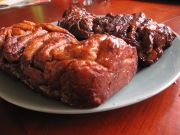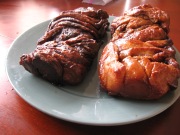I’ve had Mejadra before on many occasions. Most notably during a family trip Israel when the Syrian great aunt of a friend produced a giant potful of Mejadra full of crispy onions that really hit the spot after a day of hiking. I can still feel the sweet explosion of those fried onions in my mouth surrounded by toothsome lentils. Where better to learn the ropes of this dish than the cookbook Jerusalem?
Ingredients:
1 1/4 cup brown or green lentils, 4 medium onions, 3 tbs flour, 1 cup sunflower oil, 2 tsp cumin, 1 1/2 tbs coriander seeds, 1 cup basmati rice, 2 tbs olive oil, 1/2 tsp tumeric, 1 1/2 tsp all spice, 1 1/2 tsp cinnamon, 1 tsp sugar, 1 1/2 cup water, salt and pepper
The Process:
First and foremost you must properly wash and clean your lentils. It won’t due to have a rock in your meal. American customers buying packaged lentils at an indoor grocery may find this step less important than their Middle Eastern counterparts shopping at outdoor markets.

To me the centerpiece of mejadra is the onions, therefore I always make extra and I focus on getting them perfectly sliced. This recipe calls for you to mix the onions in a flour mixture before frying them in sunflower oil. My main issue was simply finding a bowl big enough to hold all the onions I was making. I had to fry them in shifts in my pan since I do not use deep fryers and this was the largest pan I’ve got. Patience is key as you want to let the onions caramelize, not get soft and mushy or burn. Steady low heat and stirring are your friends and they will reward you with some of the best onions I have ever tasted. Truly these onions were outstanding and I was ready to sit down and eat without before proceeding with the rest of the recipe.
Luckily the rest of the reci
pe was not that tough. You mix rice with oil and a spice mixture, add water slowly and perform the required amount of stirring and simmering. It takes a little patience to wait for the simmering, and between the onions and the rice cooking I would not claim this dish is quick, but it is simple. I taste the rice several times to make sure it was not too crunchy.

When all was mixed together my personal preference would have been for a higher onion to rice ratio, simply because the rice and lentils were the same as usual, while the onions were out of this world.
The Results:
I do not ever want to
try another fried onion recipe as this one is simply too delicious to be improved (although I will, since I’ve got plenty in this stack of cookbooks). It’s a hearty, filling and inexpensive meal, although it can take a bit more prep time than many of us has on a typical weeknight. I’m also not sold on the lentil/rice mixture. I’ve had similar that required fewer ingredients.


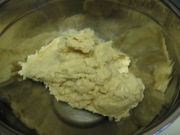
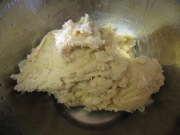
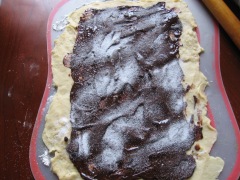 was pleasantly surprised to find the dough, when chilled, was not too sticky. The chocolate filing was honestly delicious to eat before it went on the dough, and spread quite nicely. Followed by a dusting of sugar the chocolate babka was ready to roll. Although the recipe calls for nuts to be added a this point, we have an allergy friendly house so I left them out. The cinnamon babka called for melted butter to be brushed onto the rolled dough rectangle, followed by a dusting of cinnamon and Muscovado sugar. I found the quantity of butter was excessive. I ended having some drip off the cake onto the table and floor and I was in a race to roll this thing up before more oozed off.
was pleasantly surprised to find the dough, when chilled, was not too sticky. The chocolate filing was honestly delicious to eat before it went on the dough, and spread quite nicely. Followed by a dusting of sugar the chocolate babka was ready to roll. Although the recipe calls for nuts to be added a this point, we have an allergy friendly house so I left them out. The cinnamon babka called for melted butter to be brushed onto the rolled dough rectangle, followed by a dusting of cinnamon and Muscovado sugar. I found the quantity of butter was excessive. I ended having some drip off the cake onto the table and floor and I was in a race to roll this thing up before more oozed off.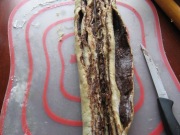
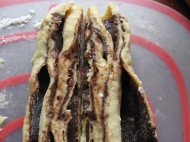
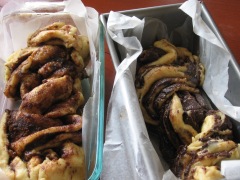
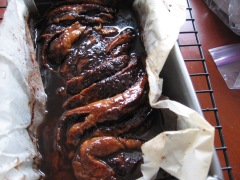 e out of the oven, the cakes get brushed with a syrup of sugar dissolved in hot water. At first the amount of syrup seems to be way too large for just two cakes, but the recipe was very clear that I must use all of it. This resulted in puddles of syrup pooling around my cakes in their loaf pans and a feeling of despair that all this work was ruined. However the cakes do absorb the syrup and I periodically went back and brushed some of the puddle over the top to help the process along. Once most of the syrup was absorbed I removed the warm cakes onto a platter and they looked really delicious, although flatter than I would expect Babka to be.
e out of the oven, the cakes get brushed with a syrup of sugar dissolved in hot water. At first the amount of syrup seems to be way too large for just two cakes, but the recipe was very clear that I must use all of it. This resulted in puddles of syrup pooling around my cakes in their loaf pans and a feeling of despair that all this work was ruined. However the cakes do absorb the syrup and I periodically went back and brushed some of the puddle over the top to help the process along. Once most of the syrup was absorbed I removed the warm cakes onto a platter and they looked really delicious, although flatter than I would expect Babka to be.